Where No Details Have Gone Before
With faster computers and easier-to-use software, designers now use CFDto explore performance on a wide range of new frontiers.
Latest News
August 1, 2005
By Pamela J. Waterman
The devil may be in the details, but seeing more detail is generally the goal. Just as astrophysicists launch new space-based telescopes to detect ever-fainter gaseous nebulae, today’s designers can choose from new tools to explore ever-finer effects in fluid flow. The combination of faster desktop computers, improved meshing, streamlined problem definition, and fantastic visualization improves the depth of vision for all levels of users across dozens of application areas and helps drive the devil out.
Feel the Flow
A BMW motorcycle is not a Harley-Davidson or a Kawasaki, and BMW strives to maintain that distinction. The company wants you to feel the difference when you twist the throttle and lean into a turn, and it’s using unique PowerFLOW fluid analysis software from Exa Corp. to get there.
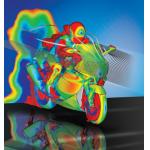 |
| This Exa PowerFLOW simulation describes the aerodynamics of a BMW motorcycle. Its surface is colored according to velocity; streamribbons demonstrate flow; and a slice behind the bike is colored according to total pressure. Image courtesy BMW AG. |
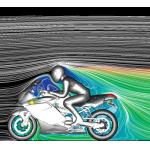 |
| This Exa PowerFLOW simulation illustrates the aerodynamics of a BMW motorcycle. The colored areas indicate velocity and the white streamlines denote the flow of the air around the motorcycle. Image courtesy of BMW AG. |
The design team needed to understand how minute differences in air pressure cause turbulence and pressure spots at every point of the model. Specifically, they sought the details of how the airstream rotates and twists as it flows past the fairing, handlebars, helmet, and the knees and legs of the rider. They also needed an easy way to conduct what-if studies as they changed elements of the model.
With Exa’s PowerFLOW analysis package, including PowerCLAY for digital volume or surface manipulation, BMW stylists and aerodynamicists work in the same room. Both groups can morph any part of the 3D bike and rider models—even changing the rider’s posture—and instantly see the effect. Drag, suction, and turbulence show clearly on the processed model images, and associated parameters such as wind noise are measurable.
When the group agrees on a final design, they capture and revise the MCAD model all in the same software environment, converting the formerly sequential design stages into a simultaneous, highly automated process.
As engineers for North Prairie, WI-based Zero Zone transitioned to the SolidWorks 3D MCAD system, they saw an opportunity to use design analysis to cut prototyping costs, improve performance, and accelerate time-to-market for their company’s line of display coolers, freezers, and refrigerated merchandising cases.
The company picked COSMOSFloWorks because of its complete integration within the SolidWorks environment and its ease of use. “Our objective was to use ]CFD] analysis software to lessen our reliance on physical prototyping…and lower development costs,” says Owen Warr, project engineer.
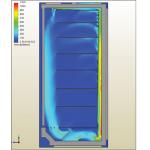 |
| Zero Zone uses COSMOSFloWorks CFD analysis software to gain an understanding of the effects of air flow on temperature distribution, product cooling, and frost build-up in its refrigerated cases. |
Zero Zone did not completely eliminate physical prototyping, but uses flow analysis to target specific areas of concern. Warr and his team use COSMOSFloWorks to get about 80% of what they need, leaving the remainder to laboratory testing and customer feedback. The software gives the company’s design engineers a greater understanding of the physical characteristics, thermal effects, and behavior of compressed air as it flows through Zero Zone cases. As a result, they design display cases that maintain specific temperatures: 40°F for refrigerated cases and –15°F for freezers.
“Without CFD, we were going along blind,” says Warr, “doing a lot of unnecessary prototyping.” Now they can minimize frost, eliminate hot and cold spots, and avoid the series of Band-Aid fixes that often resulted in the past.
Hot Programs, Cool BoxConsumers are the ultimate judges of product performance, especially TV viewers counting on the playoffs or end-of-season episodes. While a survivor may face being voted off the island, home media systems face an equally daunting task to stay on the set—set-top, that is.
Pace Micro Technology of West Yorkshire, England, is one of the world’s largest dedicated developers of digital TV set-top box technology and the only company to design such boxes for all broadcast platforms, including cable, satellite, traditional signal, and digital broadband media. In the highly competitive set-top box market, a difference of a month or two in bringing a product to market can make the difference between success and failure. Moreover, increasing disk-drive reliability and overall life can help.
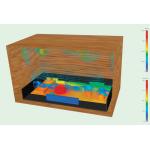 |
| Pace Micro Technology used FLOTHERM software from Flomerics to predict airflow and temperatures in a digital TV receiver box. Image courtesy of Flomerics. |
To cut the time needed to build and test box enclosure prototypes, Alan Bate, senior design engineer for Pace Micro, needed a fast way to analyze cost versus thermal performance for different venting arrangements, heat-sink geometries, and materials. He used FLOTHERM CFD thermal simulation software from Flomerics to simulate the case’s overall performance while ensuring that design changes still met electromagnetic compatibility requirements.
While other components function adequately with indirect exhaust cooling, hard drives need a fan. Bate needed to investigate the benefits of a special finned cowling he designed to augment airflow and carry it around the hard drive, especially to its sides. The cowling would create a thermal path for heat generated by both the hard-drive’s motor and air friction from the disk itself, spinning at 7200 rpm.
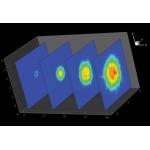 |
| Vertical slices through turbulence data showing pressure iso-surfaces in a jet engine simulation. Image courtesy of David Glaze, Purdue University. |
You’ve heard of storm chasers who track and observe tornados in the face of danger. Well, Dave Glaze of Purdue University is a jet chaser, minus the risk. He tracks the trails of jet aircraft and gets visual results equally stunning to those of the storm chasers. But Glaze uses his own supercomputer CFD software plus a desktop postprocessing package from Tecplot to peer deeply into the physics of turbulent combustion to help improve its efficiency while reducing pollution.
A stepping-stone to these improvements involves creating simulations that duplicate experimental data measured during actual aircraft flights. So far, Glaze’s CFD code occupies the resources of 16 parallel processors. In the past, sifting, manipulating, and displaying millions of data points presented a daunting task. Today, he easily manages the data from 10,000 hours of CPU time with Tecplot 2D and 3D plotting software.
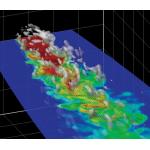 |
| This is a horizontal data slice of a pressure iso-surface showing small-scale turbulence structure in a jet engine simulation. Image courtesy of David Glaze, Purdue University. |
Solid Tecplot images clearly show time-averaged snapshots of gaseous fuel mixing with air in three dimensions. Rotation, zooming, and translation features allow slicing such images into detailed x,y views. By evaluating presentations of axial velocity decay and radial velocity profiles, Glaze can judge the effectiveness of the turbulence models and numerical method chosen for his code, and thus make software improvements that will drive better engine designs. Race Cars 101
How much of your school curriculum included designing, building, and racing Formula 1 cars? Probably not much, but you might wish you were a student today in the United Kingdom. Students in secondary schools, colleges, and organized youth groups design and manufacture CO2-powered model racing cars in an annual F1 in Schools design challenge.
The Challenge was created by partners Denford, BAE Systems, and Jaguar to help change perceptions of careers in engineering, science, and technology “by creating a fun and exciting learning environment.” What they hadn’t planned on was how CFD would play a role.
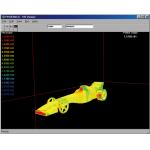 |
Concentration Heat and Momentum (CHAM) Ltd. couldn’t resist helping with the project and then enhancing the challenge by offering CFD services to the young designers. The company, known since 1974 for its PHOENICS software, imports the students’ MCAD models into its Formula 1 Virtual Wind Tunnel (F1 VWT)—an example of CHAM’s online month-by-month CFD services—for analysis. The students alter initial settings, boundary conditions, and other factors and start up the solver.
By seeing the connections between design details and simulated velocity and pressure profiles, students learn valuable lessons about refining car body styling to improve performance. They adjust the MCAD model, run new simulations, and export their final design to a CNC routing machine that carves the car from balsa wood. As the races begin, it’s clear the CFD competitive edge is starting younger every day.
Contributing editor Pamela J. Waterman is an electrical engineer and freelance technical writer based in Arizona. You can contact her about this article by clicking here. Please reference August 2005 CFD article.
CFD Is Everywhere
Aircraft and autos may have been the driving force behind the development of CFD, but useful and intriguing applications have since exponentially expanded. Here are just a few. — PW
Plastics injection molding
Blood flow in arteries and stents
Fire propagation in parking garages
Droplet and spray vaporization
Flow in combustion engines
Petroleum separation
Copy machine cooling
Weather probe tracking
Companies Mentioned
BAE Systems
Bristol, UK
CD-adapco
Melville, NY
CHAM Ltd.
London, UK
SolidWorks Corp.
Concord, MA
Denford Ltd.
Brighouse, West Yorkshire, UK
Exa Corp.
Burlington, MA
Flomerics, Inc.
Marlborough, MA
Jaguar Motor Company
Coventry, UK
Pace Micro Technology
Shipley, West Yorkshire, UK
Tecplot, Inc.
Bellevue, WA
Zero Zone
North Prairie, WI
Subscribe to our FREE magazine, FREE email newsletters or both!
Latest News
About the Author
Pamela Waterman worked as Digital Engineering’s contributing editor for two decades. Contact her via .(JavaScript must be enabled to view this email address).
Follow DE





